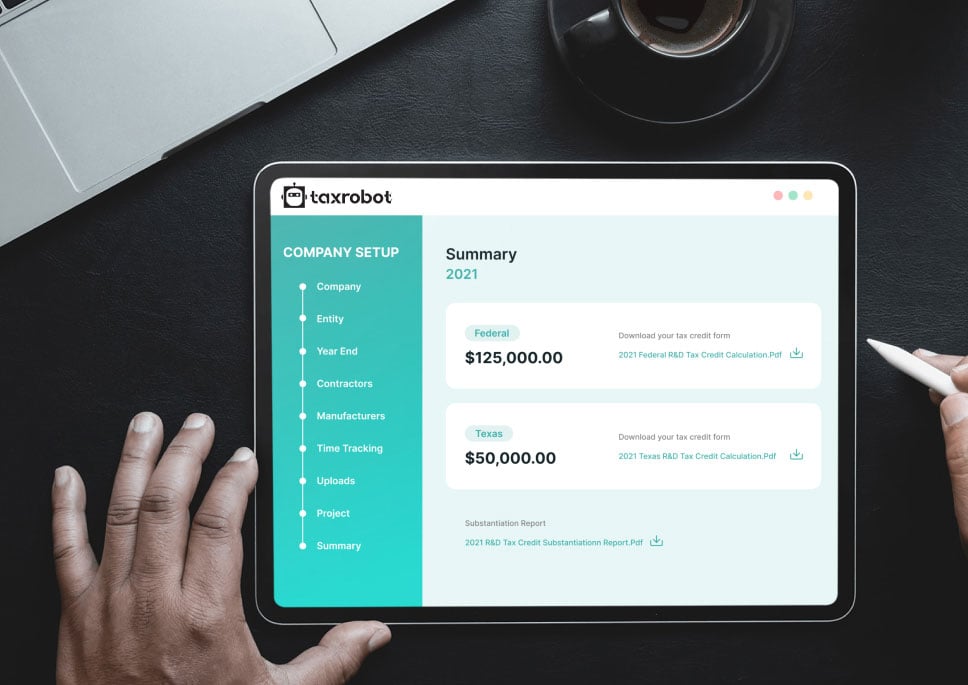Louisiana R&D Credit
Get started with TaxRobot, and let us optimize your R&D credits.
Maximize your State Credits today!
Put the R&D tax credit process on autopilot.
Trusted By:








Louisiana R&D Credit
Discover your eligibility for Louisiana R&D tax credits and supercharge your enterprise.
Are R&D Tax Credits Available in Louisiana?
Louisiana does have an R&D credit available to businesses that conduct research in the state. In addition, these businesses are also eligible for the federal tax credit.
Federal R&D Tax Credit
Just like the Louisiana credit, the federal credit aims to encourage businesses to conduct research with the intent of improving employment and innovation in these industries. The federal credit is governed by IRC Section 41, on which the Louisiana credit is based. However, since there are differences, it’s important to understand the requirements of both credits thoroughly.
Successfully applying for the federal credit can provide a business with a credit of up to 6-8% of its qualifying research expenses.
Louisiana Research and Development Tax Credit
One of the biggest differences between Louisiana’s research credit and the federal one is that the base amount and amount of the credit is impacted by how many employees a business has. If a business has 50 or more employees, its base amount is 80% of the average expenses for the previous three years. If it employs less than 50 people, this drops to 50%.
The amount of credit for a business employing under 50 people is 30%. This becomes 10% for those employing 50-99 people and 5% for those that employ 100 or more people.
If a taxpayer receives a federal SBTT or SBIR grant, they are allowed a credit of 30% of the award received during that tax year.
The credit may be carried forward for five years.
Is Your Business Eligible?
C-corporations, S-corporations, LLCs, and partnerships are all eligible for the Louisiana credit.
Certain businesses are not eligible for the credit. This includes professional services firms without a pending or issued US patent related to the QREs they are claiming. In addition, a business that doesn’t have a related patent and is primarily engaged in custom fabricating and manufacturing is not eligible.
In addition to your business itself being eligible, your expenses must also qualify. Qualified research expenses must pass a four-part test. This ensures they are technological in nature, of a permitted purpose, eliminate uncertainty, and follow an experimentation procedure. In addition, research activities must occur in Louisiana. However, activities that occur outside the state but in the country may still be eligible for the federal credit.
Requirements for the Louisiana R&D Credit
Before a business can claim the credit, it must apply for and be approved for a credit certification from Louisiana Economic Development. This application does have a fee.
Many businesses do not need to file an expenditure verification report. However, those with fewer than 50 employees who haven’t filed for the federal R&D credit with Form 6765 will need to. In addition, businesses that are not applicants for the Small Business Innovation Research Program or the Small Business Technology Transfer Program will need to file the report.
The credit must be claimed within one year following December 31 of the year the expenses were incurred.
Make It Easy to Claim Your R&D Tax Credits with TaxRobot
The Louisiana R&D credit is a bit confusing, especially since there are differences depending on the type of business and how many employees you have. However, it can result in significant tax savings and is worth it not to overlook.
If you want to claim the Louisiana and federal R&D credits but are nervous about the application and documentation, let TaxRobot help. We know the credits inside and out, meaning we can help you get the largest credit you’re eligible for. Plus, we take the guesswork out by providing audit-proof paperwork and assisting you if you are ever audited.
How Much Could Your Tax Credit Be?
Wondering just how much you could save with the Louisiana R&D credit? Use our calculator and find out.
Take a sneak peak

- Limited Time Offer
- Simple Onboarding
- Easy to Use
R&D Tax Credits FAQs
The four-part test as outlined in the Internal Revenue Code is used to determine qualified R&D activity.
The Four-Part Test
1). New Or Improved Business Component
Creation of a new product, process, formula, invention, software, or technique; or improving the performance, functionality, quality, or reliability of existing business component.
- Construction of new buildings or renovation of existing buildings
- Invention of a software application
- Manufacturing of a new product or the improvement of the production process for an existing product
- Creation of design documentation
2). Technological In Nature
The activity fundamentally relies on principles of the physical or biological sciences, engineering, or computer science. A taxpayer does not need to obtain information that exceeds, expands or refines the common knowledge of skilled professionals in a particular field.
- Physics (relationship between mass, density and volume; loading as the
result of gravitational attraction) - Engineering (mechanical, electrical, civil, chemical)
- Computer science (theory of computation and design of computational systems)
3). Elimination Of Uncertainty
Uncertainty exists if the information available to the taxpayer does not establish the capability or method for developing or improving the business component, or the appropriate design of the business component.
- The capability of a manufacturer to create a part within the specified tolerances
- The appropriate method of overcoming unsuitable soil conditions during construction
- The appropriate software design to meet quality and volatility requirements
4). Process Of Experimentation
A process designed to evaluate one or more alternatives to achieve a result where the capability or method of achieving that result, or the appropriate design of that result, is uncertain as of the beginning of the taxpayer’s research activities.
- Systematic process of trial and error
- Evaluating alternative means and methods
- Computer modeling or simulation Prototyping Testing
The R&D tax credit is one of the most misunderstood tax incentives available. Considering the myriad of industries and activities that legally qualify for the credit, the term “research and development” is a misnomer. Additionally, the R&D tax credit requires specialized knowledge and technology to identify and calculate the incentive properly.
Companies of various industries are unaware that they are eligible to claim the R&D tax credit. Under the Internal Revenue Code’s definition of R&D, many common activities qualify. You can get tax benefits for industries including software, technology, architecture, engineering, construction, manufacturing, and more.
The R&D tax credit can be claimed for all open tax years. Generally, open tax years include the prior three tax years due to the statute of limitations period. In certain circumstances, the law allows businesses to claim the R&D tax credit for an extended period of time. It is common for companies to amend previous tax years to claim this benefit and reduce the maximum amount of tax liability.
Partnerships and S corporations must file this form to claim the credit. The credit will flow from the Form 6765, to the Schedule K-1, to the Form 3800 on the individual’s tax return. For individuals receiving this credit that have ownership interest in a partnership or S corporation, Form 6765 is not required on the individual return.
Individuals claiming this credit can report the credit directly on Form 3800, General Business Credit if their only source for the credit is a partnership, S corporation, estate, or trust. Otherwise, Form 6765 must be filed with the individual’s tax return (e.g. sole proprietorship).
For tax years prior to 2016, the credit can be used to reduce the taxpayer’s regular tax liability down to the tentative minimum tax. The credit cannot be used to offset alternative minimum tax. Beginning in tax year 2016, eligible small businesses have expanded utilization for the credit. For these eligible small businesses, the regular tax liability can offset alternative minimum tax using the “25/25” rule.
What our customers have to say
I highly recommend TaxRobot to anyone considering an R&D Tax Credit software to complete their analysis.

We decided to switch to TaxRobot… Best decision we’ve ever made. More affordable, and less complicated.

I couldn’t believe how easy it was! In under an hour, we saved enough money to hire a new employee.
